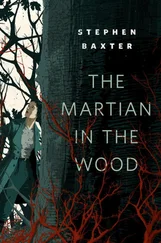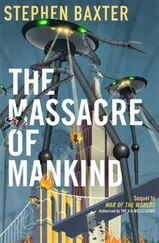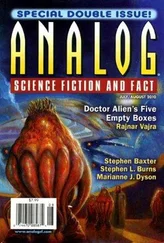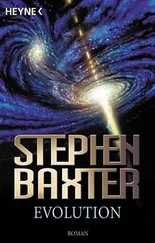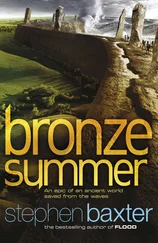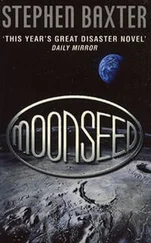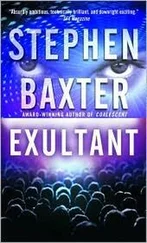Mark smiled at her. “You’d better face it, Louise. You and I grew up on worlds, and so we think in terms of rebuilding what we’ve lost. We’d better move aside, and leave the future to these bright young kids.”
She found herself grinning back. She whispered, “Okay, I take your point. But Morrow, as a bright young kid?”
“Maybe we’ll just build ships,” Spinner said intently. “Whole armadas of them. We can simply fly; who needs to land, anyway? We could spread out, here. Maybe the Xeelee are here already — we came through their gateway, after all. We could see if we can find them…”
Mark scratched his chin. “That’s a good agenda, Spinner-of Rope. You know, I think Garry Uvarov would be proud of you.”
She glared at him. She pulled her hands away from Louise, and for a moment with her streak of scarlet face paint, and spectacles glinting with New Sol light — Spinner reminded Louise of the savage little girl she’d once been.
“Maybe he would,” Spinner snapped. “But so what? I’m not a creation of Garry Uvarov. Uvarov was an oppressor, insane.”
Louise shrugged. “Perhaps he was, in the end — and capricious. But he was also insightful, iconoclastic. He never let us turn away from the truth, in any situation, no matter how uncomfortable that was…”
Uvarov hadn’t deserved to die, blind and alone, in a remote, deserted future.
Maybe Uvarov had been right, too, in the motives behind his great eugenics experiment. Not in his methods, of course… But perhaps a natural, technology independent immortality was a valid goal for the species.
Louise was aware that she and her crew had gone to a great deal of trouble to preserve the essence of humanity, through the collapse of the baryonic Universe. They hadn’t sent mere records of humankind through the Ring, or Virtual representations of what man had been: they’d brought people, with all their faults and ambiguities and weaknesses, and plumbing. And now that they’d succeeded, perhaps it was time for human stock to begin to develop: to face up to and exceed the limitations, of body and spirit, which had, at last, caused the extinction of humanity in the old, abandoned Universe.
She wondered if in several generations’ time, the descendants of Spinner-of-Rope would indeed sail through this new universe in their sparkling ships. Perhaps when they finally met the Xeelee, it would be on equal terms; perhaps the new humans would be strong, immortal — and sane.
“…It’s starting!” Morrow said, his voice high and tense. He pointed, his sleeve riding up his arm. “Look at that.”
In a sudden eruption of light, gas blossomed from the four faces of the Interface. Still fusion-burning as it emerged, the gas rapidly expanded into a growing, cooling cloud. Louise could see the tetrahedral form of the Interface itself at the blazing heart of this animated sculpture of gas.
Diffuse light flooded the pod. It was as if a new, tiny star had ignited, here on the fringe of New Sol’s gravity well. The drones flickered open their electromagnetic scoops and moved into the glowing, dispersing clouds, browsing patiently.
“Lethe’s waters,” Morrow breathed. “It’s beautiful. It’s like a flower.”
“More than that,” Mark said with a grin. “It’s beautiful because it’s bloody worked.” He turned to Louise, his blue eyes brilliant, and his face looked youthful and alive.
“Louise,” he said, “I think we might live through this after all.”
Louise reached for the pod’s controls. The first loads of atmospheric gases would be arriving soon. And there were homes to be built. It was time to return to the Northern and get back to work.
Life would go on, she thought: as complicated, and messy, and precious, as ever.
Once again Lieserl spread her arms and soared through the interior of a star. But now her playground was no mere G type yellow dwarf like the Sun: this was New Sol — a super giant, salvaged for her from the dawn of time, fully ten million miles across.
Lethe’s waters. I’d forgotten how wonderful this feels how restrictive a human body could be…
I was born for this, she thought.
She arced upwards toward the photosphere — the star’s surface was a wall of gas which seared space at a temperature of a hundred thousand degrees — and then she dived, yelling, down into the core. In Sol, the fusing core had been confined to the innermost few percent of the diameter. Here, the core was the star, extending out almost to the photosphere itself. There was fusion burning everywhere. All around her helium burned into oxygen, dumping prodigious quantities of heat energy into the star’s opaque flesh. In response, immense convective cells — some of them large enough to have swallowed Sol itself surged through the interior.
This star was no more than a couple of million years old. But already — to her intense regret — she’d missed one of the most interesting phases of its existence.
The star had formed as a ball of fusing hydrogen, two thousand times more massive than the Sun. There had been convection cells then, too, which had driven instabilities in the giant star; it had breathed, swelling and contracting through fully a tenth of its diameter in a day. The instabilities had grown, exponentially, resulting at last in the casting off of huge shells of material from the surface of the star, like a series of repeated nova explosions; the Northern had sailed in through those ancient shells, on its way to its orbit around the new sun.
Meanwhile, the helium core had grown, and steadily contracted, and heated up.
At last, the core reached half the mass of the original VMO — about a thousand Solar masses. And a shell of hydrogen around the core ignited.
The mass of three Suns was flashed to energy within mere hours — expending energy that could have fueled Sol for ten billion years of steady burning. The wind from the explosion stripped off the still-fusing envelope, creating another expanding shell around a remnant helium star.
Now, as Lieserl flew through the star, the helium was in turn burning to oxygen, which was being deposited in the star’s core. Eventually, the oxygen would ignite. And then -
And then, the outcome wasn’t certain. Her processors were still working on predictions: gathering data, developing scenarios. It all depended on critical values of the star’s mass. If the mass was low enough the star could survive, for many millions of years, its diameter oscillating slowly… and rather dully, Lieserl thought. But a little larger and the star could destroy itself in a supernova explosion — or, if massive enough, collapse into a black hole.
Lieserl studied the data streams trickling into her awareness. She would know soon. She felt a shiver of excitement. If the star was unstable, the end would come well within a million years. And then -
…Lieserl?
The voice of Louise Ye Armonk broke into her thoughts. Damn. Lieserl lifted her arms over her head and plunged into a huge convection fountain; the fusing star stuff played over her Virtual body, warming her to the core.
But she couldn’t escape Louise’s voice, any more than she’d been able to outrun Kevan Scholes.
Come on, Lieserl. I know you can hear me. I’m monitoring your data feeds, remember —
Lieserl sighed. “All right, Louise. Yes, I can hear you.”
Lieserl — Louise hesitated, uncharacteristically.
“I think I know what you’re going to say, Louise.”
Yes. I bet you do, Louise growled. Lieserl, we’re grateful to you for going into New Sol with the wormhole Interface. And you’re sending us a lot of great data. But…
Читать дальше

